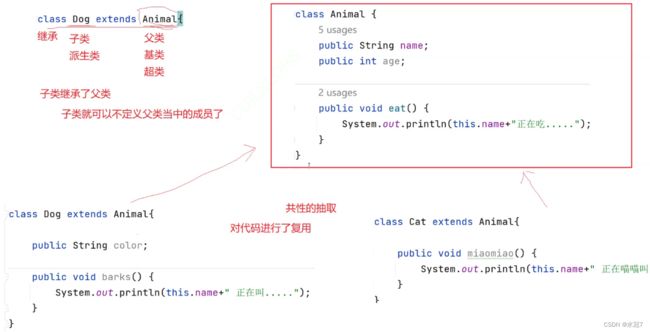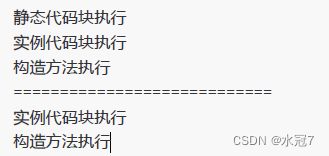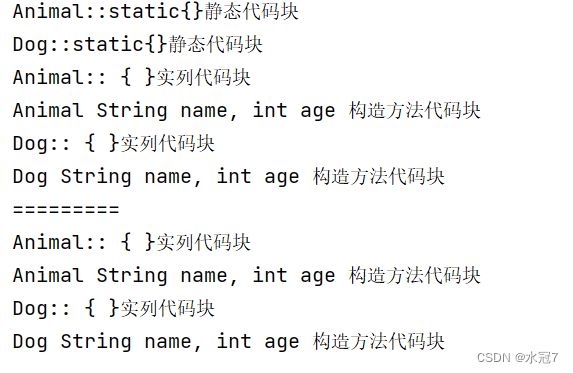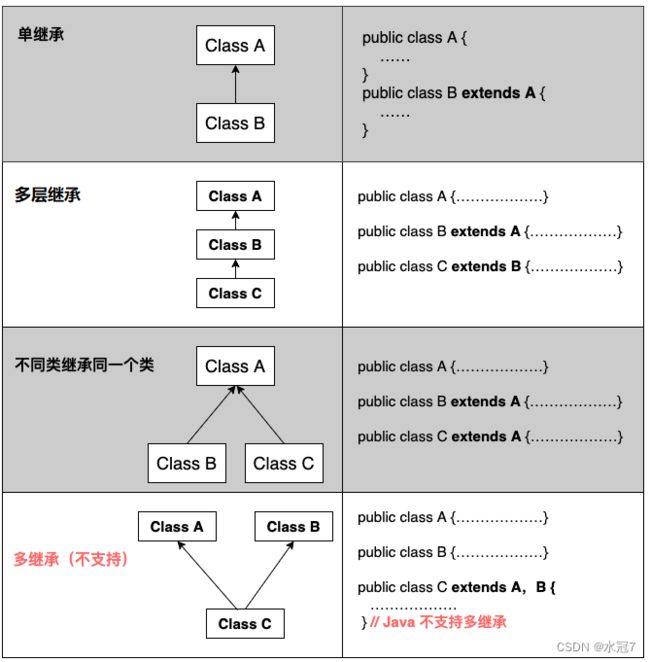【Java0基础学Java第八颗】 -- 继承与多态 -- 继承
8.继承与多态
- 8.1 继承
-
- 8.1.1 为什么需要继承
- 8.1.2 继承概念
- 8.1.3 继承的语法
- 8.1.4 super关键字
- 8.1.5 父类成员访问
-
- 子类中访问父类的成员变量
- 子类中访问父类的成员方法
- 8.1.6 子类构造方法
- 8.1.7 super和this
- 8.1.8 再谈初始化
- 8.1.9 protected 关键字
-
- 同一包中同一类
- 同一包中不同的类
- 不同包中的子类
- 8.1.10 继承方式
-
- 8.1.11 final关键字
- 8.1.12 继承与组合
8.1 继承
8.1.1 为什么需要继承
Java中使用类对现实世界中实体来进行描述,类经过实例化之后的产物对象,则可以用来表示现实中的实体,但是现实世界错综复杂,事物之间可能会存在一些关联,那在设计程序是就需要考虑。
比如:狗和猫,它们都是一个动物。
class Dog {
public String color;
public String name;
public int age;
public void eat() {
System.out.println(this.name + "正在吃。。。。");
}
public void barks() {
System.out.println(this.name + "正在叫。。。");
}
}
class Cat {
public String name;
public int age;
public void eat() {
System.out.println(this.name+ "正在吃。。。");
}
public void miaomiao() {
System.out.println(this.name+" 正在喵喵。。。");
}
}
public class Test {
public static void main(String[] args) {
Dog dog = new Dog();
dog.name = "旺财";
dog.eat();
dog.barks();
Cat cat = new Cat();
cat.name = "小咪咪";
cat.eat();
cat.miaomiao();
}
}
在上面狗类和猫类,存在name,age,还有eat方法重复,而面向对象思想中提出了继承的概念,专门用来进行共性抽取,实现代码复用。
8.1.2 继承概念
继承(inheritance)机制:是面向对象程序设计使代码可以复用的最重要的手段,它允许程序员在保持原有类特 性的基础上进行扩展,增加新功能,这样产生新的类,称派生类。继承呈现了面向对象程序设计的层次结构, 体现了由简单到复杂的认知过程。继承主要解决的问题是:共性的抽取,实现代码复用。
比如:狗和猫都是动物,那么我们就可以将共性的内容进行抽取,然后采用继承的思想来达到共用。
8.1.3 继承的语法
在Java中如果要表示类之间的继承关系,需要借助extends关键字,具体如下:
修饰符 class 子类 extends 父类 {
// ...
}
class Animal {
public String name;
public int age;
public void eat() {
System.out.println(this.name + "正在吃。。。。");
}
}
class Dog extends Animal{
public String color;
public void barks() {
System.out.println(this.name + "正在叫。。。");
}
}
class Cat extends Animal{
public void miaomiao() {
System.out.println(this.name+" 正在喵喵。。。");
}
}
public class Test {
public static void main(String[] args) {
Dog dog = new Dog();
dog.name = "旺财";
dog.eat();
dog.barks();
Cat cat = new Cat();
cat.name = "小咪咪";
cat.eat();
cat.miaomiao();
}
}
注意:
- 子类会将父类中的成员变量或者成员方法继承到子类中了
- 子类继承父类之后,必须要新添加自己特有的成员,体现出与基类的不同,否则就没有必要继承了
8.1.4 super关键字
由于设计不好,或者因场景需要,子类和父类中可能会存在相同名称的成员,如果要在子类方法中访问父类同名成员时,该如何操作?直接访问是无法做到的,Java提供了super关键字,该关键字主要作用:在子类方法中访问父类的成员。
 1.super表示的是 从父类继承过来的数据的引用。
1.super表示的是 从父类继承过来的数据的引用。
2.super的出现 ,极大的提高了代码的可读性。
注意:
- 不能出现在static方法当中
- 在子类方法中,访问父类的成员变量和方法
8.1.5 父类成员访问
子类中访问父类的成员变量
- 子类和父类不存在同名成员变量
- 子类和父类成员变量同名 - 使用super.成员
class base {
public int a = 1;
public int b = 2;
}
class Derive extends base {
public int a = 10;
public int c = 3;
public void method() {
// 优先访问子类的 子类没有 访问父类的
System.out.println(this.a); //子类和父类都有 优先访问子类的
System.out.println(super.a); //如果想要访问父类继承下来的 使用super.
System.out.println(this.b); //访问子类的
System.out.println(super.b); //访问从父类继承下来的
System.out.println(this.c); //访问子类自己的
}
}
public class Test2 {
public static void main(String[] args) {
Derive derive = new Derive();
derive.method();
}
}
注意:
- 如果访问的成员变量子类中有,优先访问自己的成员变量。
- 如果访问的成员变量子类中无,则访问父类继承下来的,如果父类也没有定义,则编译报错。
- 如果访问的成员变量与父类中成员变量同名,则优先访问自己的。如果想要访问父类,通过super.来访问。
子类中访问父类的成员方法
- 成员方法名字不同
- 在子类方法中或者通过子类对象访问方法时,则优先访问自己的,自己没有时再到父类中找,如果父类中也没有则报错。
- 成员方法名字相同
- 通过子类对象访问父类与子类中不同名方法时,优先在子类中找,找到则访问,否则在父类中找,找到则访问,否则编译报错。
- 通过派生类对象访问父类与子类同名方法时,如果父类和子类同名方法的参数列表不同(重载),根据调用方法适传递的参数选择合适的方法访问,如果没有则报错;
- 同名也可以使用super.方法来调用父类的方法
class base {
public int a = 1;
public int b = 2;
public void test() {
System.out.println("Base::test");
}
}
class Derive extends base {
public int a = 10;
public int c = 3;
public void test() {
System.out.println("Derive::test()");
}
public void test2() {
System.out.println("Derive::test2()");
}
public void test(int a) {
System.out.println(a);
}
public void method() {
test(); //优先访问子类自己的test
super.test(); // 访问父类的
test2();
test(10);
/*// 优先访问子类的 子类没有 访问父类的
System.out.println(this.a); //子类和父类都有 优先访问子类的
System.out.println(super.a); //如果想要访问父类继承下来的 使用super.
System.out.println(this.b); //访问子类的
System.out.println(super.b); //访问从父类继承下来的
System.out.println(this.c); //访问子类自己的*/
}
}
public class Test2 {
public static void main(String[] args) {
Derive derive = new Derive();
derive.method();
}
}
8.1.6 子类构造方法
子类继承了父类之后 一定先帮助父类进行成员的初始化 – 》 使用构造方法进行初始化。
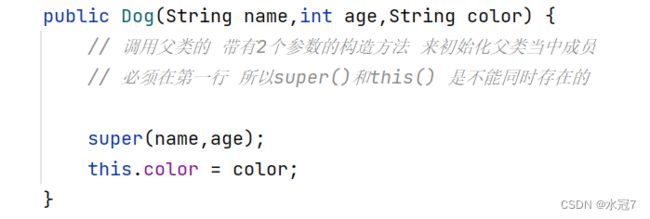
产生子类对象的时候, 父类的成员就要初始化好。
不然就会编译报错如下:
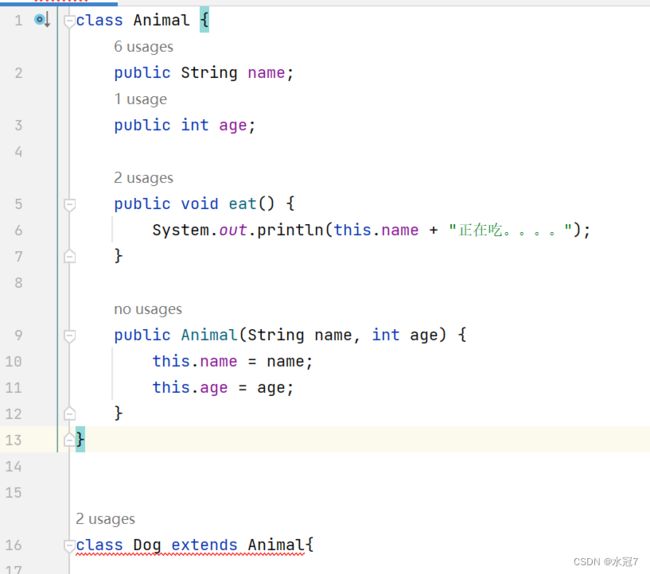
class Animal {
public String name;
public int age;
public void eat() {
System.out.println(this.name + "正在吃。。。。");
}
public Animal(String name, int age) {
this.name = name;
this.age = age;
}
}
class Dog extends Animal{
public String color;
public Dog(String name,int age,String color) {
// 调用父类的 带有2个参数的构造方法 来初始化父类当中成员
// 必须在第一行 所以super()和this() 是不能同时存在的
super(name,age);
this.color = color;
}
public void barks() {
System.out.println(this.name + "正在叫。。。");
}
}
class Cat extends Animal{
public Cat() {
super("咪咪",10);
}
public void miaomiao() {
System.out.println(this.name+" 正在喵喵。。。");
}
}
public class Test {
public static void main(String[] args) {
Dog dog = new Dog("旺财",10,"白色");
dog.eat();
Cat cat = new Cat();
cat.eat();
}
}
在子类构造方法中,并没有写任何关于基类构造的代码,但是在构造子类对象时,先执行基类的构造方法,然后执行子类的构造方法,因为:子类对象中成员是有两部分组成的,基类继承下来的以及子类新增加的部分 。父子父子肯定是先有父再有子,所以在构造子类对象时候 ,先要调用基类的构造方法,将从基类继承下来的成员构造完整
,然后再调用子类自己的构造方法,将子类自己新增加的成员初始化完整 。
注意:
- 若父类显式定义无参或者默认的构造方法,在子类构造方法第一行默认有隐含的super()调用,即调用基类构造方法
- 如果父类构造方法是带有参数的,此时需要用户为子类显式定义构造方法,并在子类构造方法中选择合适的父类构造方法调用,否则编译失败。
- 在子类构造方法中,super(…)调用父类构造时,必须是子类构造函数中第一条语句。
- super(…)只能在子类构造方法中出现一次,并且不能和this同时出现
8.1.7 super和this
super和this都可以在成员方法中用来访问:成员变量和调用其他的成员函数,都可以作为构造方法的第一条语句,那他们之间有什么区别呢?
【相同点】
- 都是Java中的关键字
- 只能在类的非静态方法中使用,用来访问非静态成员方法和字段
- 在构造方法中调用时,必须是构造方法中的第一条语句,并且不能同时存在
【不同点】
- this是当前对象的引用,当前对象即调用实例方法的对象,super相当于是子类对象中从父类继承下来部分成员的引用
- 在非静态成员方法中,this用来访问本类的方法和属性,super用来访问父类继承下来的方法和属性
- 在构造方法中:this(…)用于调用本类构造方法,super(…)用于调用父类构造方法,两种调用不能同时在构造方法中出现
- 构造方法中一定会存在super(…)的调用,用户没有写编译器也会增加,但是this(…)用户不写则没有
8.1.8 再谈初始化
实例代码块和静态代码块。在没有继承关系时的执行顺序。
class Person {
public String name;
public int age;
public Person(String name, int age) {
this.name = name;
this.age = age;
System.out.println("构造方法执行");
}
{
System.out.println("实例代码块执行");
}
static {
System.out.println("静态代码块执行");
}
}
public class TestDemo {
public static void main(String[] args) {
Person person1 = new Person("bit",10);
System.out.println("============================");
Person person2 = new Person("gaobo",20);
}
}
- 静态代码块先执行,并且只执行一次,在类加载阶段执行
- 当有对象创建时,才会执行实例代码块,实例代码块执行完成后,最后构造方法执行
在继承的代码里:
class Animal {
public String name;
public int age;
static {
System.out.println("Animal::static{}静态代码块");
}
{
System.out.println("Animal:: { }实列代码块");
}
public Animal(String name, int age) {
this.name = name;
this.age = age;
System.out.println("Animal String name, int age 构造方法代码块");
}
public void eat() {
System.out.println(this.name + "正在吃。。。。");
}
}
class Dog extends Animal{
public String color;
static {
System.out.println("Dog::static{}静态代码块");
}
{
System.out.println("Dog:: { }实列代码块");
}
public Dog(String name,int age,String color) {
// 调用父类的 带有2个参数的构造方法 来初始化父类当中成员
// 必须在第一行 所以super()和this() 是不能同时存在的
super(name,age);
this.color = color;
System.out.println("Dog String name, int age 构造方法代码块");
}
public void barks() {
System.out.println(this.name + "正在叫。。。");
}
}
class Cat extends Animal{
public Cat() {
super("咪咪",10);
}
public void miaomiao() {
System.out.println(this.name+" 正在喵喵。。。");
}
}
public class Test {
public static void main(String[] args) {
Dog dog = new Dog("旺财",10,"白色");
System.out.println("=========");
Dog dog1 = new Dog("旺财",10,"白色");
}
}
结论:
- 父类静态代码块优先于子类静态代码块执行,且是最早执行
- 父类实例代码块和父类构造方法紧接着执行
- 子类的实例代码块和子类构造方法紧接着再执行
- 第二次实例化子类对象时,父类和子类的静态代码块都将不会再执行
8.1.9 protected 关键字
在类和对象章节中,为了实现封装特性,Java中引入了访问限定符,主要限定:类或者类中成员能否在类外或者其他包中被访问。
同一包中同一类
package demo1;
//同一包中同一类
public class TestDemo1 {
protected int a;
public static void main(String[] args) {
TestDemo1 testDemo1 = new TestDemo1();
System.out.println(testDemo1.a);
}
}
// 结果为0
同一包中不同的类
package demo1;
//同一包中不同的类
public class TestDemo2 {
public static void main(String[] args) {
TestDemo1 testDemo1 = new TestDemo1();
System.out.println(testDemo1.a);
}
}
// 结果为0
不同包中的子类
package demo2;
import demo1.TestDemo1;
// 不同包中的子类 使用super访问
public class Test extends TestDemo1 {
public void func() {
/* TestDemo1 testDemo1 = new TestDemo1();
System.out.println(testDemo1.a);*/
System.out.println(super.a);
}
public static void main(String[] args) {
}
}
// 结果为0
另外在不同包中的非子类不能访问。
8.1.10 继承方式
8.1.11 final关键字
1.修饰变量或者字段,表示常量(不能被修改)
final int a = 10; //常量 不能再修改了
//a = 20;
System.out.println(a);
2.修饰类:表示该类不能被继承
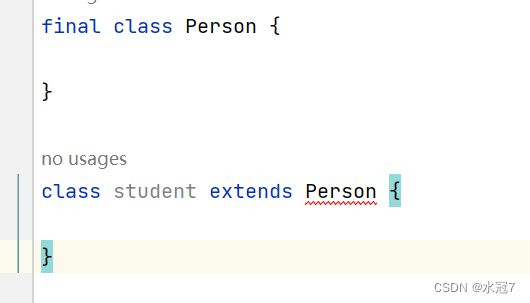 3.final还可以修饰方法,代表当前方法不能被重写
3.final还可以修饰方法,代表当前方法不能被重写
8.1.12 继承与组合
和继承类似, 组合也是一种表达类之间关系的方式, 也是能够达到代码重用的效果。组合并没有涉及到特殊的语法(诸如 extends 这样的关键字), 仅仅是将一个类的实例作为另外一个类的字段。
继承表示对象之间是is-a的关系,比如:狗是动物,猫是动物
组合表示对象之间是has-a的关系,比如:学校
学校和其学生、老师等的关系就应该是组合,因为学校是有这些部分组成的。
class Student2 {
}
class Teacher {
}
class School {
public Student2[] student2s = new Student2[10];
public Teacher[] teachers = new Teacher[5];
}
public class TestPart {
}
组合和继承都可以实现代码复用,应该使用继承还是组合,需要根据应用场景来选择,一般建议:能用组合尽量用组合。
